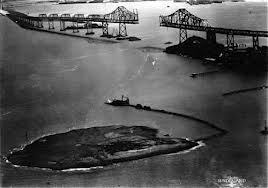In 1937, an artificial island called Treasure Island was built from fill and sand for the 1939-1940 Golden Gate International Exposition to celebrate the recently completed Golden Gate Bridge and the Oakland Bay Bridge. Treasure Island was purchased by the U.S. Navy during World War II for use as a naval training academy.
In 1946, the Navy detonated atomic bombs on the Bikini Atoll. Ships that were present in the area of the tests were damaged by the blasts and coated with radioactive calcium by fallout. Some of these ships came back to San Francisco. One of the contaminated ships from the Bikini tests was used as a class room on Treasure Island to prepare naval recruits for nuclear warfare. Some of the recruits expressed concerns about exposure to radioactive contamination.
In 1950, a student at the Damage Control Training Center on Treasure Island spilled radium-226. The Navy decontaminated the building and shipped dozens of barrels of the resulting waste out to sea. The building remained seriously contaminated even after the cleanup. In 1955, memos about Treasure Island mention that there was a shortage of staff and poor record-keeping.
In 1956, a barge designated as YFNB-29 arrived at Treasure Island covered in radioactive rust. A handwritten note stated that bilge pumps, salt water lines and diesel engines must not be worked on without a radiological survey and radiation safety precautions. In 1957, a mocked-up landlocked ship called the U.S.S. Pandemonium is fitted with equipment to raise and lower samples of cesium-137 so sailors can rehearse using radiation detection devices.
In 1966, the Navy built a Damage Control School on Treasure Island and rebuilt the Pandemonium so it could be issued a license to store cesium-137 in a vault on the island. In 1972, the chief of naval technical training for Treasure Island filed an application with the Nuclear Regulatory Commission for renewal of a license to store twelve radioactive samples on the Island including cobal-60 and cesium 137. In 1974, Navy Radiological Affairs Support officers visited the island and found samples of cesium-137, plutonium, and "a number of miscellaneous radioluminescent devices, held in a plastic bag." The inspectors ordered that these samples and devices be disposed of according to standard procedures which allowed them to be buried on the island.
In 1982, the Navy issues a manual that explained the proper use of radioactive material in the classrooms on Treasure Island. The manual covered plutonium, tritium and cesium-137. There are warnings in the manual for the students to avoid being exposed to leaking radiation for nuclear materials. In 1986, inspectors from the Nuclear Regulatory Commission, the National Institutes of Health and the Navy’s Radiological Affairs Support Office visited Treasure Island. The inspectors informed officials on the island that they had not followed radioactive safety protocol. The Treasure Island staff had failed to routinely check for leakage of plutonium, cesium and other materials. In 1988, a report of an inspection by the Naval Facilities Engineering Command discussed potential radioactive contaminants such as potassium-42, sodium-24, radium-226, cesium-137 and plutonium-239 on the island.
In 1993, there was an inventory of all radioactive materials on Treasure Island. In all ninety eight radioactive samples were listed including cesium-137, plutonium-239, strontium-90, cadmium-109 and cobalt-60. In 1997, following the decommissioning of the Naval facilities on Treasure Island, The Treasure Island Citizens Reuse Committee began planning for redevelopment of the island including apartments, commercial development and open spaces.
Treasure Island under construction:
